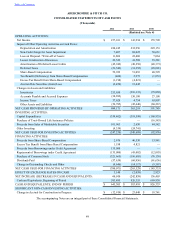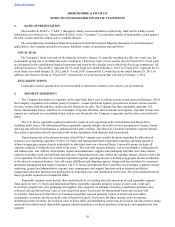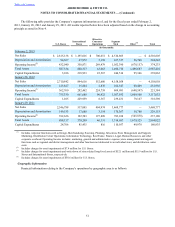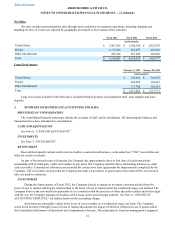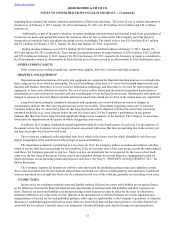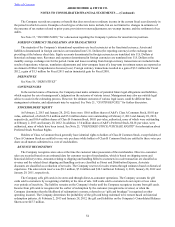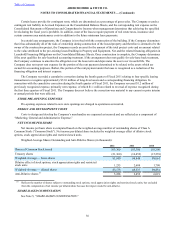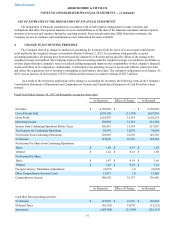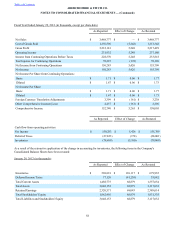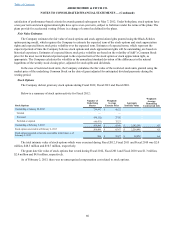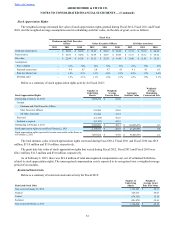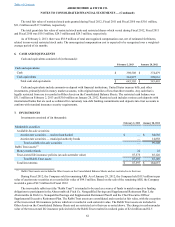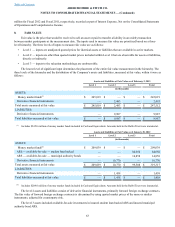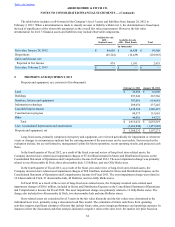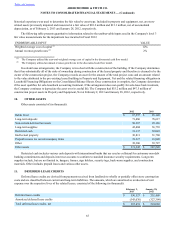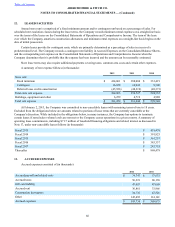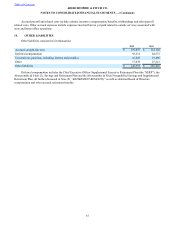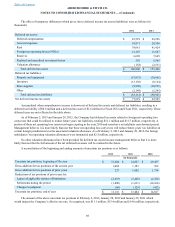Abercrombie & Fitch 2013 Annual Report Download - page 59
Download and view the complete annual report
Please find page 59 of the 2013 Abercrombie & Fitch annual report below. You can navigate through the pages in the report by either clicking on the pages listed below, or by using the keyword search tool below to find specific information within the annual report.
59
5. SHARE-BASED COMPENSATION
Financial Statement Impact
The Company recognized share-based compensation expense of $52.9 million, $51.1 million and $40.6 million for Fiscal
2012, Fiscal 2011 and Fiscal 2010, respectively. The Company also recognized $20.1 million, $19.2 million and $14.7 million
in tax benefits related to share-based compensation for Fiscal 2012, Fiscal 2011 and Fiscal 2010, respectively.
The fair value of share-based compensation awards is recognized as compensation expense on a straight-line basis over
the awards’ requisite service period, net of forfeitures. For awards that are expected to result in a tax deduction, a deferred tax
asset is recorded in the period in which share-based compensation expense is recognized. A current tax deduction arises upon
the vesting of restricted stock units or the exercise of stock options and stock appreciation rights and is principally measured at
the award’s intrinsic value. If the tax deduction is greater than the recorded deferred tax asset, the tax benefit associated with
any excess deduction is considered a “windfall tax benefit” and is recognized as additional paid-in capital. If the tax deduction
is less than the recorded deferred tax asset, the resulting difference, or shortfall, is first charged to additional paid-in capital, to
the extent of the pool of “windfall tax benefits,” with any remainder recognized as tax expense. The Company’s pool of
“windfall tax benefits” as of February 2, 2013, is sufficient to fully absorb any shortfall which may develop associated with
awards currently outstanding.
Share-based compensation expense is recognized, net of estimated forfeitures, over the requisite service period on a
straight-line basis. The Company adjusts share-based compensation expense on a quarterly basis for actual forfeitures and for
changes to the estimate of expected award forfeitures based on actual forfeiture experience. The effect of adjusting the
forfeiture rate is recognized in the period the forfeiture estimate is changed. The effect of adjustments for forfeitures was $1.3
million, $1.6 million and $4.5 million for Fiscal 2012, Fiscal 2011 and Fiscal 2010, respectively.
A&F issues shares of Common Stock for stock option and stock appreciation right exercises and restricted stock unit
vestings from treasury stock. As of February 2, 2013, A&F had sufficient treasury stock available to settle stock options, stock
appreciation rights and restricted stock units outstanding without having to repurchase additional shares of Common Stock.
Settlement of stock awards in Common Stock also requires that the Company has sufficient shares available in stockholder-
approved plans at the applicable time.
In the event, at each reporting date during which share-based compensation awards remain outstanding, there are not
sufficient shares of Common Stock available to be issued under the Amended and Restated Abercrombie & Fitch Co. 2007
Long-Term Incentive Plan (the “2007 LTIP”) and the Abercrombie & Fitch Co. 2005 Long-Term Incentive Plan (the “2005
LTIP”), or under a successor or replacement plan, the Company may be required to designate some portion of the outstanding
awards to be settled in cash, which would result in liability classification of such awards. The fair value of liability-classified
awards is re-measured each reporting date until such awards no longer remain outstanding or until sufficient shares of Common
Stock become available to be issued under the 2007 LTIP, or under a successor or replacement plan. As long as the awards are
required to be classified as a liability, the change in fair value would be recognized in current period expense based on the
requisite service period rendered.
Plans
As of February 2, 2013, A&F had two primary share-based compensation plans: the 2005 LTIP, under which A&F grants
stock options, stock appreciation rights and restricted stock units to associates of the Company and non-associate members of
the A&F Board of Directors, and the 2007 LTIP, under which A&F grants stock options, stock appreciation rights and restricted
stock units to associates of the Company. A&F also has four other share-based compensation plans under which it granted stock
options and restricted stock units to associates of the Company and non-associate members of the A&F Board of Directors in
prior years.
The 2007 LTIP, a stockholder-approved plan, permits A&F to annually grant awards covering up to 2.0 million of
underlying shares of A&F’s Common Stock for each type of award, per eligible participant, plus any unused annual limit from
prior years. The 2005 LTIP, a stockholder-approved plan, permits A&F to annually grant awards covering up to 250,000 of
underlying shares of A&F’s Common Stock for each award type to any associate of the Company (other than the Chairman and
Chief Executive Officer (the "CEO") ) who is subject to Section 16 of the Securities Exchange Act of 1934, as amended, at the
time of the grant, plus any unused annual limit from prior years. In addition, any non-associate director of A&F is eligible to
receive awards under the 2005 LTIP. Under both plans, stock options, stock appreciation rights and restricted stock units vest
primarily over four years for associates. Under the 2005 LTIP, restricted stock units typically vest after approximately one year
for non-associate directors of A&F. Awards granted to the CEO under the 2007 LTIP have a vesting period defined as the
shorter of four years or the period from the award date through the end of the CEO's employment agreement subject to the
Table of Contents ABERCROMBIE & FITCH CO.
NOTES TO CONSOLIDATED FINANCIAL STATEMENTS — (Continued)


